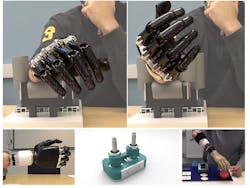Flex Your Wrist with the Help of Some Robotic Joints
There are two main motions when you flex or rotate your wrist. When you lay your hand flat on a table with your palm down, the wrist is said to be pronated. On the other hand, turning your wrist 180 deg. so the hand is facing palm up places it in what’s known as a supinated position. For patients missing a hand, finding a prosthetic which has the full ability to pronate and supinate is extremely difficult. Think about the number times you rotate your wrist to perform everyday functions: This movement is essential to opening a door, turning a knob, or flipping over a piece of paper.
To help address the problem, a group of researchers led by Max Ortiz Catalan, an associate professor at Chalmers University of Technology in Sweden, recently published “Restoring Natural Forearm Rotation in Transradial Osseointegrated Amputees” in the journal IEEE Transactions on Neural Systems & Rehabilitation Engineering. Accompanying its publication, the team has introduced a new artificial joint which restores wrist-like movements to forearm amputees.
The new artificial joint works with an osseointegrated implant system developed by the Swedish company, Integrum AB. An implant is surgically placed into each of the forearm’s two bones (the ulna and radius). Patients who have lost a hand and wrist still possess enough musculature to rotate the radius over the ulna. A wrist-like artificial joint acts as an interface between the implants and the prosthetic hand. By having the controls implanted into the existing bone structure, patients are offered a different, more natural means of operating the prosthesis.
Patients who have lost their hand and wrist often still preserve enough musculature to allow them to rotate the radius over the ulnar—the crucial movement in wrist rotation. The new device capitalizes on this ability and uses it to operate the robotic interface. (Credit: Biomechatronics and Neurorehabilitation Laboratory/Chalmers University of Technology)
Traditionally, a conventional socket prosthesis is attached to the body by compressing the stump and locking the bones in place. This prevents any potential wrist rotation, wasting useful movement. Then a person missing their wrist could use a motorized wrist controlled by an electric rotator. Signals are transmitted from the remaining muscles to control the rotation, but these same signals control the open and closing of the prosthetic hand.
According to Catalan, this dual control system is problematic and causes less than desired performance. “[The] results [are] very cumbersome and unnatural control scheme, in which patients can only activate either the prosthetic wrist or the hand at one time and have to switch back and forth,” he explains. “Furthermore, patients get no sensory feedback, so they have no sensation of the hand’s position or movement.”
The researchers found that restoring a full range of motion was not the key to a successful wrist device. Being able to restore enough of natural wrist motion was sufficient for providing the patient with a more human-like prosthetic. The key parameter was returning the axial or circular motion of the ulnar and radius bones.
“The wrist is a rather complicated joint,” explains Catalan. “Although it is possible to restore full freedom of movement in the ulnar and radial bones, this could result in discomfort for the patient at times. We found that axial rotation is the most important factor to allow for naturalistic wrist movement without this uncomfortable feeling.”
Catalan and his team are hopeful their new device can return normal functionality to amputees, and that they “don’t have to sacrifice this useful movement because of a poor technological solution, such as a socket prosthesis. You can continue to [live] in a natural way.”


